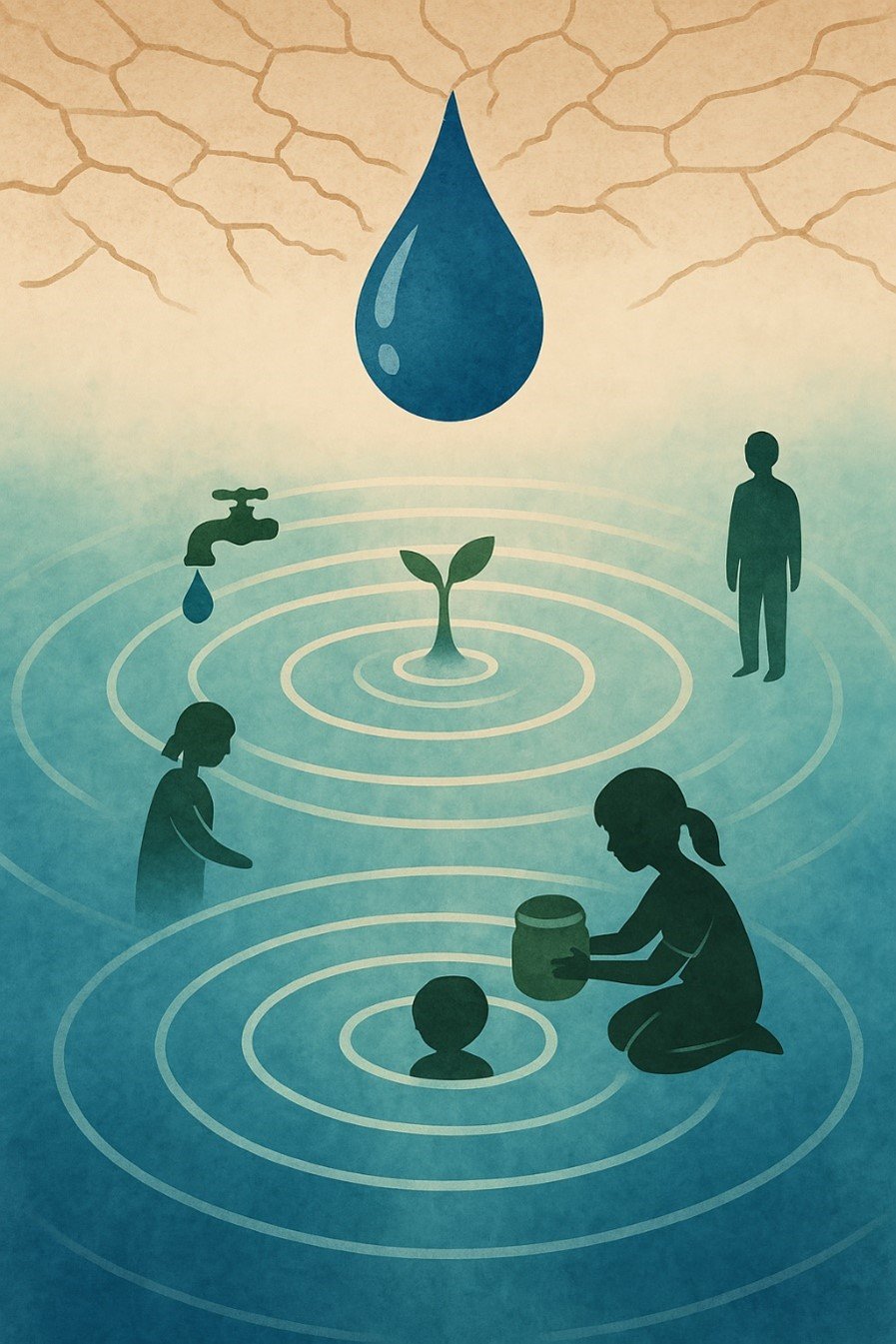As Audience / Responding
In exploring the sustainability theme of Clean Water and Healthy Living through the Arts, I chose two artworks that directly address the issue of clean water, the rights that come with it, and the urgency with which this requires action. Both of these works, Water is Life by Cannupa Hanska Luger and Clean Water Saves Lives by Holly Thomas, represent different media, cultural perspectives, and aesthetic approaches but hold shared goals to make the public aware of the importance of water justice in everyday life. Secondly, as a viewer, I analysed the two works critically, making sense of how water is portrayed not only as a resource but also as a social, cultural, and human right.
Artwork: Water is Life by Cannupa Hanska Luger
- Medium: Mixed media installation and performance
- Artist: Cannupa Hanska Luger (USA)
- Link: https://www.cannupahanska.com/social-engagement/mirror-shield-project
This artwork was created during the Standing Rock protests against the Dakota Access Pipeline, which threatened the Sioux Tribe's clean water supply (Cannupa Hanska Luger, 2025). Mirrored shields made from recycled materials used in protest performances were utilised in the installation. The subject then reflects on both the natural landscape and the militarised opposition to turning the viewer's gaze inward and outward. This movement helped to spread the phrase 'Water is Life,' a phrase now globally recognised as resistance and reverence for water.
Luger’s purpose in the artwork was to reclaim the sacredness of water in service to Indigenous voices and environmental defenders. This is a good use of reclaimed materials to meet the themes of sustainability and a good performance area to tell emotional and cultural stories. Visually striking and emotionally provocative, I found this work as an audience member. It forced me to think about how environmental matters relate to cultural sovereignty as well as activism. This artwork can support inquiry on how different communities protect and value water in a primary school context. The responding strand states that students are encouraged to interpret and reflect on how artists use visual and symbolic techniques to communicate social issues (ACARA, 2017). The work itself is multi-layered and I chose it because of its potential to provoke classroom discussion.
Artwork: Clean Water Saves Lives by Holly Thomas
- Medium: Digital illustration
- Artist: Holly Thomas (UK)
- Link: https://www.wateraid.org/uk/blog/using-art-to-demand-clean-water-meet-our-winner
This piece was a winner of WaterAid’s ‘Art of Change’ competition, and it was made to promote universal access to clean water, sanitation, and hygiene. The picture illustrates unity and people from different ages and cultures encircling a huge flow of water, implying that everybody is responsible for that. Blue and green tones create a calmness and cleaner feeling, with the use of the water being centred to represent its very basis of life (Water Aid, 2020). Thomas hoped to convey this message of hope and encourage governments to take urgent action. The work itself is accessible, emotionally engaging, and visually clean, which would make it suitable to be viewed by primary-aged audiences. It enables children to think about health, fairness, and how art can be a way to change. I chose it because it tells complex global issues through an easy-to-understand, universal visual story framed based on the principles of the United Nations Sustainable Development Goal 6, which aims to ensure that everyone has access to safe and sustainable water and sanitation. (United Nations, 2023). These two works alongside each other serve as a model example of how art can be a platform for advocating sustainable action and promoting clean water to children as a right and a necessity.
As Artist / Making
In my creative response, I digitally illustrated a visual artwork titled Ripple Effect with symbolic imagery, colour gradients, and compositions to show that clean water has positive effects on our lives. My process began with research into symbolic representational water. Taking a step backwards, I brainstormed and digitally sketched several ideas until I chose a central water droplet falling onto a dry, dry surface, creating ripples and spreading outward. It features each ripple containing human silhouettes, plant life, and sanitation icons, including a faucet or water container to represent the positive impacts of clean water on different aspects of life. Digital layering was used to build texture and flow, and the repositioning of some of the elements in a balanced and visual hierarchy. I began to manipulate tonal gradients and contour lines throughout the ripple effect to bring in more contrast and motion. The transitions between dry and hydrated earth were carefully coloured to underscore the change that clean water makes to people and communities.
Artist Statement
In Ripple Effect, I wanted to demonstrate that clean water does not just satisfy a basic need; it is also a powerful force for change. Through the visual connection of water and sanitation, health and environmental growth, I pursued to impress the viewers, especially young learners, that water is a shared global issue. This stands as a metaphor for how the ripples from small actions would lead to creating a bigger social change, it encourages that any efforts undertaken for water conservation or advocacy would result in change. The work supports the Arts curriculum's aims to "represent social issues" and "stimulate critical thinking and empathy through visual means" (ACARA, 2017) by embedding these themes artistically. I hope that this work encourages action and thoughtful discussion.